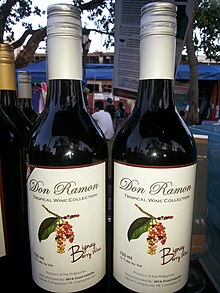Antidesma bunius
| Antidesma bunius | |
|---|---|

| |
| Leaves and flowers of bignay in the Berlin Botanical Garden and Botanical Museum | |

| |
| Ripe bignay fruit in the Philippines | |
| Scientific classification | |
| Kingdom: | Plantae |
| Clade: | Tracheophytes |
| Clade: | Angiosperms |
| Clade: | Eudicots |
| Clade: | Rosids |
| Order: | Malpighiales |
| Family: | Phyllanthaceae |
| Genus: | Antidesma |
| Species: | A. bunius
|
| Binomial name | |
| Antidesma bunius | |
Antidesma bunius is a species of
Description

It is a variable plant which may be short and shrubby or tall and erect, approaching 30 metres (98 feet) in height. It has large oval-shaped leathery evergreen leaves up to about 20 centimetres (8 inches) long and 7 cm (3 in) wide. They are attached to the twigs of the tree with short petioles, creating a dense canopy.
The species is
Each bunch of fruits ripens unevenly, so the fruits in a bunch are all different colors. The skin of the fruit has red juice, while the white pulp has colorless juice. The fruit contains a light-colored seed. The fruit has a sour taste similar to that of the cranberry when immature, and a tart but sweet taste when ripe.
There is an inverse correlation between the ability to taste phenylthiocarbamide and bitterness in A. bunius.[2]
Distribution and habitat
The native range of wild trees of Antidesma bunius extends from parts of
Uses
The fruits are edible raw.
See also
- Antidesma montanum
- Syzygium curranii (lipote)
- Syzygium polycephaloides (lipote)
References
- ^ a b "Antidesma bunius". Germplasm Resources Information Network. Agricultural Research Service, United States Department of Agriculture. Retrieved 10 January 2018.
- PMID 834304.
- ^ ISBN 9789400740532.
- ^ )
- ^ De Leon y German, José (1916). "Forms of Some Philippine Fruits". The Philippine Agriculturist and Forester. 5 (8): 251–280.
External links
- Purdue New Crops Profile
- Antidesma Species Accounts
- Wild Cherry Tea PhenQGuide.net
- Getting To Know The Bignay Tree CitraRespati.eu.org
